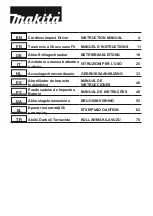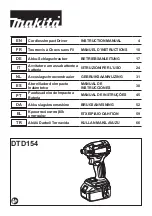
English
9
This does not work for reverse rotation. Operation
continues until the switch trigger is released
regardless of the dial setting.
(2) Dial setting
Turn the dial and align the number center section
(depression) with the housing triangle mark on the
left side of the dial. The dial can not be set at positions
between numbers (
Fig. 7
).
The appropriate dial position depends on the screw
and tightening material type. Try test tightening a few
screws to adjust the dial to the appropriate setting.
NOTE
䡬
Do not move this dial during operation. Doing so can
cause malfunction.
䡬
For wood, the tightening state varies greatly with the
wood type, grain, knots, etc. For such work, it is
recommended that the stopper also be used.
5. How to install and use a stopper
For those using the stopper standard accessory
specifications
(1) Install the bit.
Install a Phillips bit with a total length (L dimension)
of 60-65 mm.
(2) Install the stopper, then fasten by tightening the wing
bolt (
Fig. 8
).
NOTE
䡬
Push the stopper securely all the way in until it makes
contact.If it not securely installed, this can cause the
tightening depth to change during work.
(3) Adjust the tightening depth (
Fig. 9
).
1
Pull the main unit lock sleeve in the A direction.
2
Turn the main unit stopper (A) and adjust how far
the bit sticks out.
3
Turning in the B direction retracts the bit and
turning in the C direction extends it.
4
Release the lock sleeve to lock the stopper (A).
(4) Tighten a few screws and check that the tightening
depth is just right.
6. Number of screws tightenings possible
Please refer to the table below for the number of screw
tightened possible with one charge.
Batteries
EB1220BL
EB1230HL
Screw used
Wood screw
Approx. 450
Approx. 675
ø4
×
50 (Soft wood)
Machine screw
Approx. 730
Approx. 2100
M8
×
16
Dial setting value
Mode
Operation
1~6
Several Impact
7~9
Timer
10
Continuous
After the start of operation, when the main unit starts the impact, it is
stopped automatically after a few impacts. The rotation rate at which the
switch trigger is pulled can be set from low speed to full speed with dial
settings of 1 (low) through 6 (full).
After the start of operation, when the main unit starts the impact, it is
stopped automatically after a certain period of time. The rotation rate when
the switch trigger is pulled is full speed and the higher the dial setting,
from 7 to 9, the longer time from the start of impact until it is stopped.
There is no automatic stopping. After operation starts, it continues until
the switch trigger is released.
Table 4
These values may vary slightly, according to
surrounding temperature and battery characteristics.
NOTE
The use of the battery EB1230HL in a cold condition
(below 0 degree Centigrade) can sometimes result in
the weakened tightening torque and reduced amount
of work. This, however, is a temporary phenomenon,
and returns to normal when the battery warms up.
OPERATIONAL CAUTIONS
1. Resting the unit after continuous work
After use for continuous bolt-tightening work, rest the
unit for 15 minutes or so when replacing the battery.
The temperature of the motor, switch, etc., will rise if
the work is started again immediately after battery
replacement, eventually resulting in burnout.
2. Cautions on use of the speed control switch
This switch has a built-in, electronic circuit which
steplessly varies the rotation speed. Consequently,
when the switch trigger is pulled only slightly (low
speed rotation) and the motor is stopped while
continuously driving in screws, the components of
the electronic circuit parts may overheat and be
damaged.
3. Tightening torque
Fig. 14-1
,
14-2
, and
14-3
show the tightening torque
for each screw and bolt size under the tightening
conditions of
Fig. 15-1
and
15-2
, so refer to these
figures.
Fig. 14-1
gives the reference values for tightening
torque for dial settings 1-9 when the impact automatic
stop function is used.
Fig. 14-2
and
14-3
give the
reference values for tightening time and tightening
torque for manual tightening using switch operation
with the dial set to 10. These tightening torques are
for tightening with the screw or bolt placed on the
seating surface. In actual work, the torque varies with
the tightening conditions, so use the values in these
tables as general yardsticks.
NOTE
䡬
If a long striking time is used, screws will be strongly
tightened. This may cause the screw to break, or may
damage the tip of the bit.
䡬
If the unit is held at an angle to the screw being
tightened, the head of the screw may be damaged, or
Содержание WH 12DK
Страница 72: ...71 ...
Страница 73: ...72 ...
Страница 74: ...73 ...
Страница 76: ...75 1 2 3 4 5 ...











































